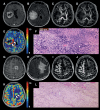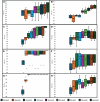Distinction of pseudoprogression from true progression in glioblastomas using machine learning based on multiparametric magnetic resonance imaging and O6-methylguanine-methyltransferase promoter methylation status
- PMID: 39502470
- PMCID: PMC11535496
- DOI: 10.1093/noajnl/vdae159
Distinction of pseudoprogression from true progression in glioblastomas using machine learning based on multiparametric magnetic resonance imaging and O6-methylguanine-methyltransferase promoter methylation status
Abstract
Background: It is imperative to differentiate true progression (TP) from pseudoprogression (PsP) in glioblastomas (GBMs). We sought to investigate the potential of physiologically sensitive quantitative parameters derived from diffusion and perfusion magnetic resonance imaging (MRI), and molecular signature combined with machine learning in distinguishing TP from PsP in GBMs in the present study.
Methods: GBM patients (n = 93) exhibiting contrast-enhancing lesions within 6 months after completion of standard treatment underwent 3T MRI. Final data analyses were performed on 75 patients as O6-methylguanine-DNA-methyltransferase (MGMT) status was available only from these patients. Subsequently, patients were classified as TP (n = 55) or PsP (n = 20) based on histological features or mRANO criteria. Quantitative parameters were computed from contrast-enhancing regions of neoplasms. PsP datasets were artificially augmented to achieve balanced class distribution in 2 groups (TP and PsP). A random forest algorithm was applied to select the optimized features. The data were randomly split into training and testing subsets in an 8:2 ratio. To develop a robust prediction model in distinguishing TP from PsP, several machine-learning classifiers were employed. The cross-validation and receiver operating characteristic (ROC) curve analyses were performed to determine the diagnostic performance.
Results: The quadratic support vector machine was found to be the best classifier in distinguishing TP from PsP with a training accuracy of 91%, cross-validation accuracy of 86%, and testing accuracy of 85%. Additionally, ROC analysis revealed an accuracy of 85%, sensitivity of 70%, and specificity of 100%.
Conclusions: Machine learning using quantitative multiparametric MRI may be a promising approach to distinguishing TP from PsP in GBMs.
Keywords: diffusion and perfusion MR imaging; glioblastoma; machine-learning; pseudoprogression; true progression.
© The Author(s) 2024. Published by Oxford University Press, the Society for Neuro-Oncology and the European Association of Neuro-Oncology.
Conflict of interest statement
The authors declare no conflict of interest. The authors have no relevant financial or nonfinancial interests to disclose.
Figures





Similar articles
-
Validation of multiparametric MRI based prediction model in identification of pseudoprogression in glioblastomas.J Transl Med. 2023 Apr 28;21(1):287. doi: 10.1186/s12967-023-03941-x. J Transl Med. 2023. PMID: 37118754 Free PMC article.
-
Three-dimensional echo planar spectroscopic imaging for differentiation of true progression from pseudoprogression in patients with glioblastoma.NMR Biomed. 2019 Feb;32(2):e4042. doi: 10.1002/nbm.4042. Epub 2018 Dec 17. NMR Biomed. 2019. PMID: 30556932 Free PMC article.
-
A deep learning model for discriminating true progression from pseudoprogression in glioblastoma patients.J Neurooncol. 2022 Sep;159(2):447-455. doi: 10.1007/s11060-022-04080-x. Epub 2022 Jul 19. J Neurooncol. 2022. PMID: 35852738
-
Metabolic and physiologic magnetic resonance imaging in distinguishing true progression from pseudoprogression in patients with glioblastoma.NMR Biomed. 2022 Jul;35(7):e4719. doi: 10.1002/nbm.4719. Epub 2022 Mar 15. NMR Biomed. 2022. PMID: 35233862 Free PMC article. Review.
-
Imaging and Liquid Biopsy for Distinguishing True Progression From Pseudoprogression in Gliomas, Current Advances and Challenges.Acad Radiol. 2024 Aug;31(8):3366-3383. doi: 10.1016/j.acra.2024.03.019. Epub 2024 Apr 12. Acad Radiol. 2024. PMID: 38614827 Review.
Cited by
-
Response Assessment in Long-Term Glioblastoma Survivors Using a Multiparametric MRI-Based Prediction Model.Brain Sci. 2025 Jan 31;15(2):146. doi: 10.3390/brainsci15020146. Brain Sci. 2025. PMID: 40002479 Free PMC article.
References
-
- Gunjur A, Lau E, Taouk Y, Ryan G.. Early post-treatment pseudo-progression amongst glioblastoma multiforme patients treated with radiotherapy and temozolomide: A retrospective analysis. J Med Imaging Radiat Oncol. 2011;55(6):603–610. - PubMed
-
- Van Mieghem E, Wozniak A, Geussens Y, et al. Defining pseudoprogression in glioblastoma multiforme. Eur J Neurol. 2013;20(10):1335–1341. - PubMed
-
- Kong DS, Kim ST, Kim EH, et al. Diagnostic dilemma of pseudoprogression in the treatment of newly diagnosed glioblastomas: The role of assessing relative cerebral blood flow volume and oxygen-6-Methylguanine-DNA Methyltransferase Promoter Methylation Status. AJNR Am J Neuroradiol. 2011;32(2):382–387. - PMC - PubMed
LinkOut - more resources
Full Text Sources
Research Materials
Miscellaneous
